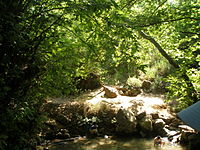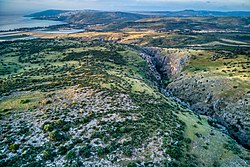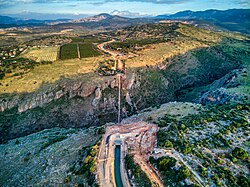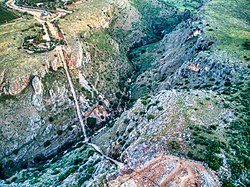| Amud | |
|---|---|
 Nahal Amud | |
| Native name | |
| Physical characteristics | |
| Source | |
| • location | Near Kadita, Israel |
| • coordinates | 33°0′46.57″N 35°28′2.87″E / 33.0129361°N 35.4674639°E |
| • elevation | 816 m (2,677 ft) |
| Mouth | Sea of Galilee |
• location | Ginosar, Israel |
• coordinates | 32°51′11.98″N 35°31′56.9″E / 32.8533278°N 35.532472°E |
• elevation | −209 m (−686 ft) |
| Length | 24.9 km (15.5 mi) |
Nahal Amud (Hebrew: נחל עמוד), also known as the Wadi al-Amud, is a stream in the Upper Galilee region of Israel that flows into the Sea of Galilee.
History
[edit]
The source of the stream, Ramat Dalton, is located 800 meters above sea level. Its drainage basin includes the peaks of Mount Canaan (955 meters) and Mount Meron (1,204 meters) and flows south through eastern Galilee to the northwest part of the Sea of Galilee – a height of less than 200 meters below sea level.
The stream is named after a pillar that rises high above ground and is located near a channel of the stream near Kibbutz Hukok. The gorge that forms the channel at this point holds many caves once inhabited by Homo heidelbergensis and later by Neanderthal Man such as the cave at Zuttiyeh and the Amud cave. They were the object of the first paleoanthropological excavations in Mandatory Palestine in 1925–1926.[1] The caves contained hominin remains as well as Mousterian and Acheulean artifacts.
Most of Nahal Amud (8923 dunams) was declared a nature reserve in 1972.[2]
Tributaries
[edit]The tributaries of the stream:
The drainage basin of the stream is bordered by the Korazim Stream and the Zalmon Stream.
Gallery
[edit]-
Looking north from Nahal Amud lookout
-
Looking south from Nahal Amud lookout
-
Water flows from the open Canal of the National Water Carrier of Israel into the inverted siphon in Nahal Amud and to the open canal on the other side
-
The inverted siphon in Nahal Amud
See also
[edit]References
[edit]- ^ Excavations in the Wadi Amud
- ^ "List of National Parks and Nature Reserves" (PDF) (in Hebrew). Israel Nature and Parks Authority. Archived from the original (PDF) on 2009-10-07. Retrieved 2010-09-27.
External links
[edit]32°52′51.31″N 35°30′11.75″E / 32.8809194°N 35.5032639°E





Well, that’s interesting to know that Psilotum nudum are known as whisk ferns. Psilotum nudum is the commoner species of the two. While the P. flaccidum is a rare species and is found in the tropical islands. Both the species are usually epiphytic in habit and grow upon tree ferns. These species may also be terrestrial and grow in humus or in the crevices of the rocks.
View the detailed Guide of Psilotum nudum: Detailed Study Of Psilotum Nudum (Whisk Fern), Classification, Anatomy, Reproduction